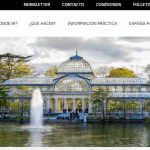SEGITTUR and minube have produced the white paper “The new traveller: This is how the tourism sector is preparing its future”, which analyses the behaviour of tourists after the pandemic based on a survey of 1,700 users, complemented by the testimonies of more than 50 renowned tourism professionals.
The book, which has been supported by Malaga City Council, was presented by the Secretary of State for Tourism, Fernando Valdés, at the Thyssen-Bornemisza National Museum, accompanied by the Director of Institutional Relations (IR) at SEGITTUR, Víctor Badorrey, and the CEO of minube, Raúl Jiménez.
The Secretary of State stressed the need to have a comprehensive view of the new tourist in the context of Covid-19, as this information will allow destinations and companies to adapt their offer to the new needs of tourists. A traveller for whom digitalisation and sustainability are key elements in managing their travel at all stages of their journey.
“Decision-making in an increasingly demanding sector requires knowing everything about the tourist: where they come from, what they like, how they pay, what experiences they are looking for as a complement to their trip, all this information is necessary for destinations and companies to get it right with the proposals they present,” explained Valdés.
For the director of IR at SEGITTUR, the study reveals the usefulness of digitalisation in tourism to offer more personalised services, as recognised by the tourists surveyed, as well as by the various experts consulted from companies, destinations and organisations such as the European Travel Commission, the UNWTO and Turespaña.
Raúl Jiménez pointed out that, “Now that we can see the light at the end of the tunnel, this white paper is intended to be an inspiration for all the new challenges and opportunities that post-covid tourism offer us. It will help us cope with these profound changes and to allow us to dream again of being a leading industry.”
What do travellers expect?
The book provides a comprehensive overview of how to deal with change or transformation in the post-pandemic tourism sector in the long term, as well as recommendations on how to cope with its effects in the short term.
To this end, it has been split into in eight large blocks that address the traveller experience, their motivations and marketing to attract them from different channels; smart destinations and the keys to tackle change from digitalisation, innovation and sustainability, as well as the trends of the new mobility and the experience of post-covid travellers in countries such as France, the United Kingdom and Norway.
Among the conclusions of the survey of more than 1,700 travellers from the minube.com community, which shows their preferences for the opening up of tourism, are shorter trips to national destinations, preferably sun and sand and inland destinations that are safe and not overcrowded.
They will travel around Spain
73% of travellers surveyed will choose to stay in a domestic destination, with 43% staying in a familiar destination and 30% wanting to discover another place. Only 18% plan to travel within Europe, while 9% will travel to a destination outside the EU.
31% of travellers will choose a sun and beach destination, compared to 31% who prefer a rural and inland destination. City tourism will be the option for 13%, as will those who will opt for social gatherings with family or friends. Sports/adventure tourism accounts for 8% of preferences.
In terms of travel dates, 70% of travellers favour July and August, while the remaining 30% will wait until the latter part of the year.
Reason for travel
Among the reasons for choosing a destination, almost half (48%) will look for an uncrowded destination, while 22% will look for safety and anti-covid measures, only 13% will prioritise price. Sustainability will be taken into account by 17% of travellers.
Fewer and shorter trips
In terms of the number of trips, 48% of travellers are expected to make 2 or 3 leisure trips this year, a decrease compared to those made in 2019. The reasons cited by travellers are security and economic reasons.
Travel times are also reduced. 42% plan to travel for one week or less, while 38% plan to travel for 1 to 2 weeks. Only 11% extend it to 3, while 5% would travel for 3 to 4. Even so, 4% are considering a getaway of more than one month.
Own car and hotel for a low cost holiday
In terms of domestic travel, 57% will travel by car, compared to 33% who will travel by air. Train and bus are the preferred choice for 5% and 3% of respondents. For accommodation, 60% opt for hotel accommodation and 20% choose to rent. 16% will go to their own home, while 4% will opt for a tent or campervan.
In terms of spending, 70% of travellers do not expect to spend more than €1,000 per person and 33% expect to spend less than €500. Only 10% estimate that their travel budget will be over €2,000.
The rise of direct booking
58% of travellers will choose to book directly with the supplier. Of these, 73.5% will opt for a domestic destination, 17.6% for Europe and 8.7% for a long-haul destination.
On the other hand, 29% of travellers will go to a travel agency. For those who go to a physical agency, 71.8% will choose a domestic destination, 18.6% will opt for Europe and the remaining 9.5% for a long-haul destination. As for online agencies, 49.1% of travellers will book services for domestic destinations, 31.3% for Europe and 19.4% for long-haul destinations.
New digital services
According to the survey, 43% of respondents value digital services in tourism for their ability to personalise trips, while 23% consider it useful for avoiding physical contact and improving safety. 20% prefer to disconnect from technology, while for 10% it can be a good ally for consuming content virtually.
Note for the editors
The SEGITTUR and minube white paper “The new traveller: This is how the tourism sector is preparing its future”, with the full findings of the survey of more than 1,700 travellers from the minube.com community, can be downloaded HERE.
The supporting graphs of the study are available at this link.
The graphic material of the event can be downloaded HERE.





